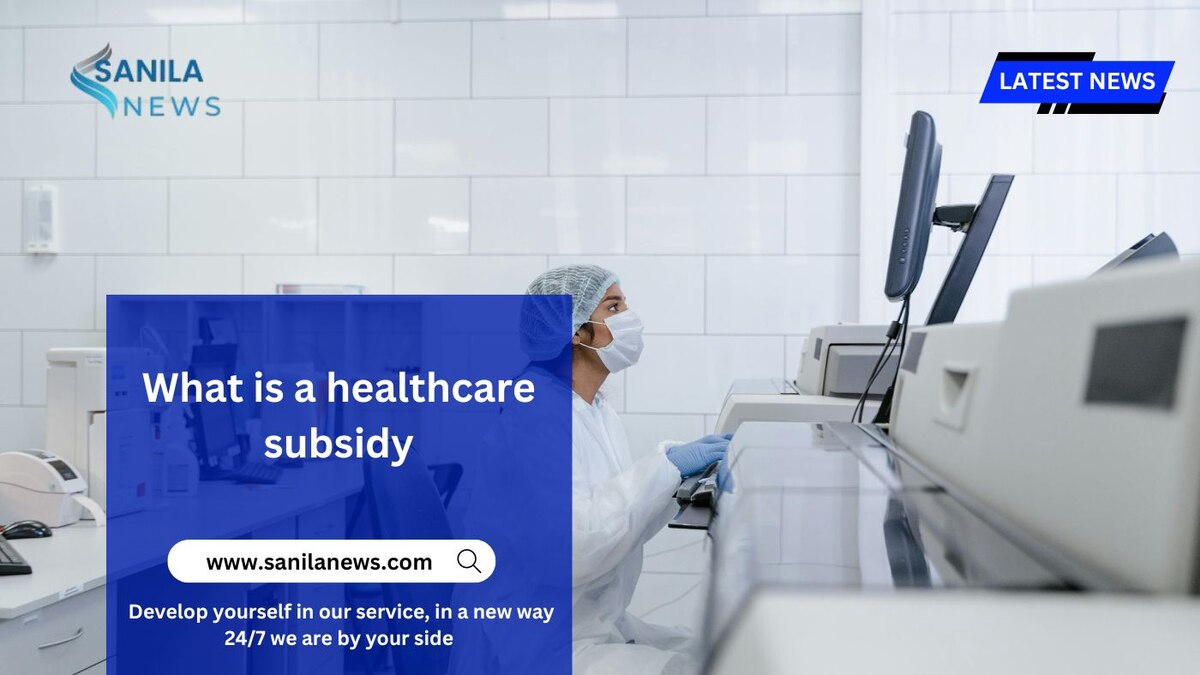What Is a Healthcare Subsidy? A Comprehensive Guide
Healthcare costs in many countries, particularly in the United States, can be prohibitively expensive for individuals and families. To make healthcare more affordable and accessible, governments often provide financial assistance known as healthcare subsidies. These subsidies are designed to lower the cost of health insurance and medical care, ensuring that more people can obtain the coverage they need. This guide will delve into what healthcare subsidies are, how they work, who qualifies for them, and their impact on the healthcare system.
What is a healthcare subsidy Understanding Healthcare Subsidies
What is a healthcare subsidy A healthcare subsidy is a form of financial assistance provided by the government to help individuals and families pay for health insurance. Subsidies can reduce the amount people pay for monthly premiums, out-of-pocket expenses, or both. In the United States, these subsidies are primarily available through the Affordable Care Act (ACA) marketplace, but other forms of healthcare subsidies exist in different programs and countries.
Types of Healthcare Subsidies
- Premium Tax Credits:
- Premium tax credits are the most common form of healthcare subsidy in the ACA marketplace. These credits reduce the amount you pay for your monthly health insurance premiums.
- How They Work: The amount of the premium tax credit is based on your household income and the cost of health insurance in your area. The credit can be applied directly to your monthly insurance premium, reducing the amount you owe each month, or it can be claimed as a lump sum when you file your taxes.
- Cost-Sharing Reductions (CSRs):
- Cost-sharing reductions lower the amount you pay out of pocket for healthcare services, such as copayments, deductibles, and coinsurance.
- How They Work: CSRs are only available to individuals who purchase Silver plans through the ACA marketplace and meet certain income criteria. These reductions are automatically applied if you qualify, lowering the costs of using your health insurance.
- Medicaid and CHIP (Children’s Health Insurance Program):
- Medicaid and CHIP are government-funded programs that provide free or low-cost health coverage to eligible low-income individuals and families.
- How They Work: Eligibility for Medicaid and CHIP is based on income, household size, and other factors. These programs are a form of healthcare subsidy as they significantly reduce or eliminate healthcare costs for enrollees.
- Employer-Sponsored Health Insurance Subsidies:
- Employers often provide subsidies to help employees pay for their health insurance premiums. These subsidies are typically a percentage of the premium cost, with the employer covering a portion and the employee paying the rest.
- How They Work: The employer’s contribution is a direct subsidy that reduces the amount an employee has to pay for their health insurance. The employee’s share is usually deducted from their paycheck pre-tax, providing additional tax savings.
How Healthcare Subsidies Are Calculated
What is a healthcare subsidy The amount of a healthcare subsidy you are eligible for depends on several factors, including your income, family size, and location. Here’s a closer look at how these factors influence the subsidy calculation:
- Income Level:
- In the ACA marketplace, premium tax credits and cost-sharing reductions are primarily based on your household income relative to the federal poverty level (FPL).
- Federal Poverty Level (FPL): The FPL is a measure of income used to determine eligibility for various government programs. In 2024, the FPL for a single person is $14,580, and for a family of four, it is $30,000. These amounts vary slightly based on the state you live in.
- Income Thresholds:
- To qualify for premium tax credits, your income generally needs to be between 100% and 400% of the FPL.
- For cost-sharing reductions, your income must be between 100% and 250% of the FPL.
- Household Size:
- Your household size, including yourself, your spouse, and your dependents, also affects your subsidy amount. Larger households with the same income as smaller households are more likely to qualify for higher subsidies.
- Location:
- The cost of health insurance varies by region due to differences in healthcare costs, insurance market competition, and other factors. Subsidies are adjusted to reflect these regional variations, meaning you may receive a higher or lower subsidy depending on where you live.
- Age:
- In some cases, age can influence the amount of a healthcare subsidy. Older individuals often face higher health insurance premiums, which can lead to larger premium tax credits to help offset the cost.
- Plan Selection:
- The specific health insurance plan you choose also impacts your subsidy. For example, cost-sharing reductions are only available on Silver plans in the ACA marketplace, so selecting a Bronze or Gold plan would not make you eligible for those reductions.
Eligibility for Healthcare Subsidies
What is a healthcare subsidy Eligibility for healthcare subsidies depends on various criteria, primarily centered around income, household size, and residency. Here’s a breakdown of the general eligibility requirements for different types of subsidies:
- Premium Tax Credits:
- Income Requirements: Your household income must be between 100% and 400% of the FPL to qualify for premium tax credits. In some cases, individuals with incomes above 400% of the FPL may also qualify due to provisions in the American Rescue Plan Act and the Inflation Reduction Act, which temporarily expanded eligibility.
- Enrollment in ACA Marketplace: You must purchase your health insurance through the ACA marketplace to qualify for premium tax credits.
- Ineligibility for Other Coverage: If you have access to affordable employer-sponsored insurance or are eligible for government programs like Medicaid or Medicare, you generally cannot receive premium tax credits.
- Cost-Sharing Reductions (CSRs):
- Income Requirements: CSRs are available to individuals with household incomes between 100% and 250% of the FPL.
- Silver Plan Enrollment: You must enroll in a Silver plan through the ACA marketplace to receive CSRs.
- Ineligibility for Other Coverage: Similar to premium tax credits, you cannot receive CSRs if you have access to affordable employer-sponsored insurance or are eligible for other government programs.
- Medicaid and CHIP:
- Income and Household Size: Eligibility for Medicaid and CHIP varies by state but is generally based on income and household size. In states that expanded Medicaid under the ACA, individuals with incomes up to 138% of the FPL are eligible.
- Residency: You must be a resident of the state where you are applying for Medicaid or CHIP.
- Citizenship: Most applicants must be U.S. citizens or legal residents to qualify for Medicaid or CHIP.
- Employer-Sponsored Health Insurance Subsidies:
- Employment Status: You must be employed and eligible for health insurance benefits through your employer.
- Full-Time Employment: Most employer-sponsored subsidies are available to full-time employees, though some part-time employees may also be eligible.
What is a healthcare subsidy The Impact of Healthcare Subsidies
Healthcare subsidies play a crucial role in making health insurance more affordable and accessible, particularly for low- and middle-income individuals and families. Here’s a closer look at the impact of these subsidies on the healthcare system:
- Increased Access to Health Insurance:
- Healthcare subsidies have significantly expanded access to health insurance. Since the implementation of the ACA, millions of Americans who previously could not afford coverage have been able to obtain health insurance through the marketplace with the help of subsidies.
- The expansion of Medicaid in many states has also provided coverage to millions of low-income individuals who were previously uninsured.
- Reduction in Uninsured Rates:
- The availability of healthcare subsidies has contributed to a substantial decrease in the number of uninsured individuals. Before the ACA, the uninsured rate in the U.S. was over 16%. By 2021, it had dropped to around 9%, largely due to the availability of subsidies and expanded Medicaid coverage.
- Financial Protection:
- Healthcare subsidies provide financial protection to individuals and families, reducing the burden of high healthcare costs. By lowering premiums and out-of-pocket expenses, subsidies help prevent financial hardship and medical debt.
- Improved Health Outcomes:
- Access to affordable health insurance through subsidies has been linked to improved health outcomes. With insurance coverage, individuals are more likely to seek preventive care, receive timely medical treatment, and manage chronic conditions effectively.
- Economic Impact:
- Healthcare subsidies also have broader economic implications. By reducing the cost of healthcare, subsidies free up income for other essential expenses, contributing to overall economic stability. Additionally, subsidies help maintain the financial viability of the healthcare system by ensuring a larger and more diverse pool of insured individuals.
Challenges and Controversies Surrounding Healthcare Subsidies
While healthcare subsidies have had a positive impact on access to health insurance, they are not without challenges and controversies. Some of the key issues include:
- Cost to Taxpayers:
- The funding for healthcare subsidies comes from taxpayers, and the cost of these subsidies has been a point of contention, particularly among those who believe government spending on healthcare should be reduced.
- The expansion of subsidies under the ACA, as well as recent temporary enhancements under the American Rescue Plan Act, have increased the financial burden on the federal budget.
- Complexity of the System:
- Navigating the healthcare subsidy system can be complex and confusing for many individuals. Understanding eligibility criteria, calculating subsidy amounts, and selecting the right health insurance plan can be challenging, leading to underutilization of available subsidies.
- Coverage Gaps:
- Despite the availability of subsidies, some individuals still fall through the cracks. For example, in states that did not expand Medicaid under the ACA, many low-income individuals remain uninsured because they earn too much
Last word
Keep an eye on our news channel Sanila News to get updated news regularly.

